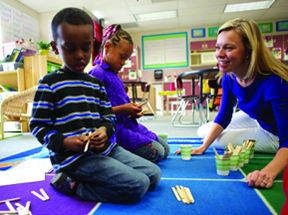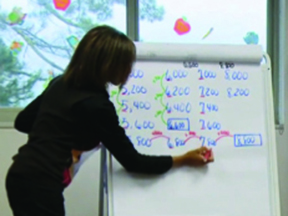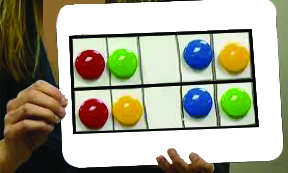By Lynsey
Gibbons and Kendra Lomax, posted December 21, 2015 –
Our second
post in this series described the big ideas about learning to count. The
Common Core State Standards in Mathematics propose that kindergarten students should
learn the counting sequence through 100; develop principles of counting, such
as one-to-one correspondence and cardinality; and represent amounts by writing
numerals. First graders expand their counting sequence to 120 and begin to
consider place-value ideas. In our experiences, children in these early grades can
count well beyond 120 with great success, suggesting that these benchmarks should
not limit our expectations for what students can do. Many young children are
ready to explore larger numbers; therefore, we give them opportunities to count
increasingly larger amounts.
Count Everything
Our go-to advice for parents who ask about how to support
their young mathematicians is to have children “count everything!” This can
begin at home in informal situations and be extended into school with more
formal situations. The opportunities to work on ideas of number and quantity
are endless: Count the stairs as you walk up, decide which bowl of cherries
contains more, organize beads into groups of ten, guess how many Legos®
you have and then find out! The Talking
Math with Your Kids blog by Christopher Danielson describes some informal
conversations with children ages 1–9. This is a great resource for everyday
mathematical conversations you could have with children.
Counting Collections:
Connecting Quantity, Verbal Counting, and Symbolic Notation
 Another way to support children in developing
these important counting ideas is by offering many opportunities for them to
count items. Counting Collections is
a structured counting activity in which children work with a partner to count
how many items are in a collection and then record their count on paper. By
working together, students develop social skills—like sharing decisions about
how to count and what to do if you disagree—as well as mathematical skills—like
strategies for keeping track, learning the counting sequence, and ideas about place
value. Counting Collections is a wonderful
opportunity for children to develop their sense of quantity and expand their
facility with the forward number sequence. Encouraging students to record their
count gives them practice with representing quantity, an important skill in
modeling and solving problems. As children gain experience with counting
objects and counting increasingly larger collections, they can explore ways to
make their counting more efficient, such as counting groups of items, arranging
the items in rows and columns, and using cups to keep track of groups of 2s,
5s, or 10s. These strategies lend themselves to developing ideas about place
value, skip counting, and multiplication. See Counting
Collections (Schwerdtfeger and Chan 2007) for further description of the
activity, including images and student work.
Another way to support children in developing
these important counting ideas is by offering many opportunities for them to
count items. Counting Collections is
a structured counting activity in which children work with a partner to count
how many items are in a collection and then record their count on paper. By
working together, students develop social skills—like sharing decisions about
how to count and what to do if you disagree—as well as mathematical skills—like
strategies for keeping track, learning the counting sequence, and ideas about place
value. Counting Collections is a wonderful
opportunity for children to develop their sense of quantity and expand their
facility with the forward number sequence. Encouraging students to record their
count gives them practice with representing quantity, an important skill in
modeling and solving problems. As children gain experience with counting
objects and counting increasingly larger collections, they can explore ways to
make their counting more efficient, such as counting groups of items, arranging
the items in rows and columns, and using cups to keep track of groups of 2s,
5s, or 10s. These strategies lend themselves to developing ideas about place
value, skip counting, and multiplication. See Counting
Collections (Schwerdtfeger and Chan 2007) for further description of the
activity, including images and student work.
Choral Counting:
Developing Verbal Counting Sequences and Symbolic Notation

Different from other oral counting activities, Choral
Counting includes both the verbal and written notation for numbers and asks
students to analyze patterns in our number system. Examining number patterns in
the count gives students opportunities to consider place-value ideas and
computation strategies. Choral Counting can also be used to work on counting
backward, an important skill in learning to solve subtraction situations in the
early years. Students typically have many more experiences with counting
forward than they do backward, and choral counting provides a meaningful
opportunity to connect and build on these patterns.
Quick Images:
Exploring Quantity through Subitizing, Composing, and Decomposing Number
 In a Quick Images activity, children are
quickly shown pictures displaying groups of objects or symbols, viewing each
for only a few seconds. The image is shown a couple of times, and then children
discuss how many objects they saw and how they saw them. This activity, which in curricula like Investigations in Number, Space, and Data by TERC, is one of our favorite
activities because it is fun, easy for teachers or parents to learn how to do,
accessible to a wide range of learners, and allows children to work on rich
mathematical ideas.
In a Quick Images activity, children are
quickly shown pictures displaying groups of objects or symbols, viewing each
for only a few seconds. The image is shown a couple of times, and then children
discuss how many objects they saw and how they saw them. This activity, which in curricula like Investigations in Number, Space, and Data by TERC, is one of our favorite
activities because it is fun, easy for teachers or parents to learn how to do,
accessible to a wide range of learners, and allows children to work on rich
mathematical ideas.
Beginning in their early years, children develop the ability
to subitize, or quickly perceive the
cardinality of a small number of objects or symbols. For example, when reading
the numbers on a die, eventually we won’t count the dots, or pips, one by one.
Rather, we will identify the X shape on dice as having five dots. We learn to
perceive other formations of small quantities without counting. By showing an
image for only a few seconds, the Quick Images activity supports children in using
subitizing to determine the total number of dots, rather than counting by ones.
This activity offers a context in which to practice composing and decomposing
numbers, which is an important skill that will later support students in using
strategies that are more efficient to add or subtract quantities.
In our fourth, and final, blog post, we will share counting
activities for intermediate grades that help students continue to develop their
understanding of our number system, connect their learning about number from
earlier grades to the larger quantities they will encounter, and develop
understanding of place value. Happy counting!
Your Turn
We
want to hear from you. Please let us know which activities you try and what
you learn; comment below or
share your thoughts on Twitter @TCM_at_NCTM using #TCMcounting.
Resources
Number Talks by
Sherry Parrish is a great resource for K–grade 1 Quick Image tasks. More
information on subitizing can be found in a 1999 TCM article
by Doug Clements.
You can find planning tools and sample tasks for Counting
Collections, Choral Counting, and Quick Images at Teacher Education by Design (TEDD). For videos of these activities, search for each
activity on the Teaching Channel.
References
TERC. 2008. Investigations
in Number, Data, and Space Series.
Pearson Scott Foresman.
Parrish, Sherry.
2010. Number Talks: Helping Children Build Mental Math and Computation
Strategies, Grades K–5. Math Solutions.


Lynsey Gibbons, @lynseymathed, is an assistant professor in mathematics
education at Boston University in Massachusetts. She is a former
elementary school teacher and mathematics coach. Her current scholarly work
seeks to understand how we can reorganize schools to support the learning of
children and adults. Kendra Lomax, @kendralomax, is a math educator at the University of
Washington in Seattle. She designs and facilitates professional learning
opportunities about elementary school mathematics through projects like TEDD.org. Curiosity about children’s mathematical
thinking is at the heart of her work. The authors would like to note that they are continually learning
about children and counting. They have learned a great deal from their
colleagues, reading the mathematics education literature, and interacting with
children about counting. The following colleagues have greatly informed their
thinking about how to support children in finding the joy in mathematics and in
counting in particular: Ruth Balf, Adrian Cunard, Megan Franke, Allison Hintz,
Elham Kazemi, Becca Lewis, Teresa Lind, Angela Chan Turrou, and many teachers
in the Seattle, Washington, area.